106 CUSTOMER REVIEWS
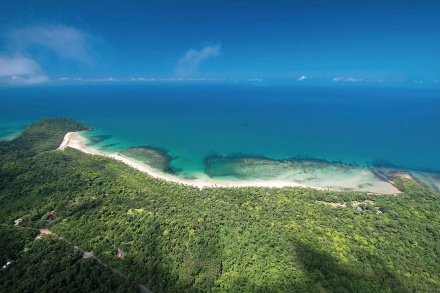
The Daintree Rainforest located in Tropical North Queensland, Australia is over 135 million years old, making it the oldest rainforest in the world.
The largest rainforest in Australia, the Daintree Rainforest is over 1,200 square kilometres and is home to many animal and plant species not found anywhere else in the world.
The Daintree Rainforest is a popular Day Trip destination from Cairns and Port Douglas. Visit Mossman gorge, experience a croc cruise on the Daintree River, cross the river on the Ferry and travel to Cape Tribulation. You can even visit the Great Barrier Reef from Cape Tribulation with Ocean Safari.
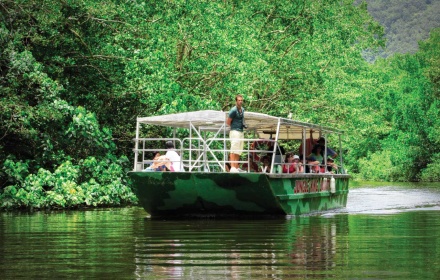
Taking a cruise on the Daintree River, located north of Port Douglas, gives you an intimate rainforest experience with the flora and fauna in this World Heritage protected region. The Daintree Rainforest is one of the largest in Australia and one of the oldest rainforests in the world, estimated at over 135 million years old. Stretching over 1,200 square hectares, you will find animal and plant species that call the Daintree home, not found anywhere else in the world.
Daintree River Cruises are operated by eco-certified low fuel consuming river vessels that produce no wash, helping to protect the environment, so people like yourself and generations to come can appreciate this amazing part of the world. This also includes limiting the number of licensed river cruise operators.
Spotting a saltwater crocodile amongst the river banks or mangroves is definitely the highlight of the Daintree river cruise. Seeing these ancient reptiles in their natural environment is much more exciting than at a zoo and what a great photo opportunity! Other animals you may encounter include hundreds of tropical bird species such as the great-billed heron and kingfishers, tree kangaroos, possums, cassowaries and goannas. Cruises are operated by informative tour guides ready to answer any questions, while you relax and enjoy the scenic ride on the Daintree River.
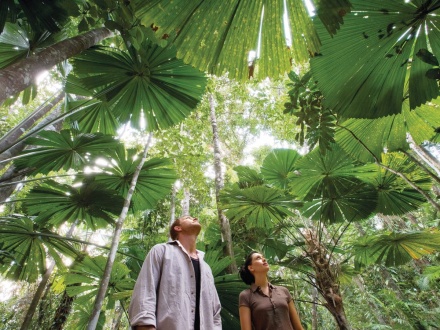
For hiking enthusiasts, the Daintree Rainforest provides a wilderness experience that ranks as one of the most exotic and challenging in the world. When hiking in this area it is vital to bring ample supplies of drinking water to combat the intense tropical humidity.
Myall Beach to Cape Tribulation Beach
One and a half hour round trip
From Myall Beach (accessed from Cape Tribulation village along a gravel track and wooden boardwalk through the mangroves) walk for a kilometre towards the cape until you reach a small creek. It is wise to cross this creek at low tide, because it can be quite deep and will saturate your boots at the very start of the hike. Not something you want to do.
200 metres past the creek is a sign pointing to Cape Tribulation beach. This track leads into the rainforest and over the Cape Tribulation headland. The hike concludes at the Cape Tribulation beach car park. Returning to Myall Beach is a simple matter of retracing your steps through the rainforest, or walking back along the road until you reach Cape Tribulation Village.
Dubiji Boardwalk
One hour round trip
At the Cape Tribulation Park is a sign pointing to the Dubuji car park. From here, the 1.8 kilometre Dubiji boardwalk meanders through the rainforest and mangroves with informative signs along the way telling stories about the plants and animals living in the area.
The boardwalk is circular, so you will return to the car park at the end of the walk.
Mardja Botanical Walk
Half an hour
At the south of Cape Tribulation, a path leads through the rainforest with informative signs posted along the way. The boardwalk reaches Oliver Creek, home of crocodiles, birds and other tropical creatures. This boardwalk is often inundated with tourists who arrive in buses, so if you want to avoid the rush it is best to make this walk early in the morning or late in the afternoon.
Mount Sorrow Ridge
Six hours return trip
This is the challenging hike in the Daintree area. The Mount Sorrow Ridge hike leads high into the mountains behind Cape Tribulation, offering wonderful views of the area. The hike begins at the National Park Office at Cape Tribulation. The office will have detailed maps of the area that show where the hike leads. Please note this is a challenging hike and is not for the faint hearted.
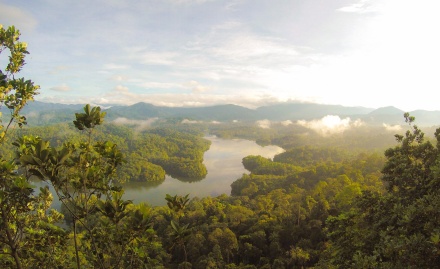
Most travellers to North Queensland have heard about the famous Daintree Rainforest. This world heritage listed Rainforest has a good walking trail that starts at Mossman Gorge only 1 hour and 30 minutes drive from Cairns or 25 minutes from Port Douglas.
Alternatively you could drive a little further and visit the Daintree Village. This little hub has some Daintree River cruises and a couple of little cafe's.
Or, for the more adventurous you may decide to go directly to Cape Tribulation. You will need to follow the signs to Cape Tribulation and the Daintree River Ferry after Mossman. We suggest you allow 2 hours and 30 minutes to drive to Cape Tribulation from Cairns and over 1 hour from Port Douglas.
The Daintree River Ferry operates from 6am to midnight daily. It is possible to take a conventional vehicle to Cape Tribulation.
The Daintree River ferry concession cards are now available for purchase by eligible residents at the Cairns Regional Council Mossman Service Centre 64-66 Front Street, Mossman. For any enquiries please contact Customer Service on (07) 4099 9444.
For tourists arriving at Cairns Airport or Cruise Ship terminal, car hire offers the freedom to travel and explore in your own time and an opportunity to see and do more than an in organised tours.
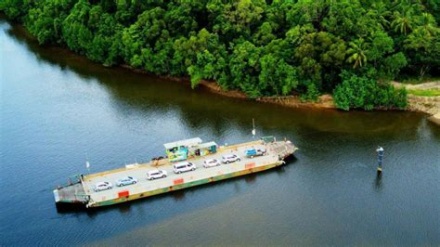
The Daintree River Ferry, 50km north of Port Douglas, is the only way to cross the river. It operates on a cable system and is capable of taking up to 16 vehicles across the river at a time. The trip from the south bank to the north bank of the river takes about 5 minutes. This is the only cable ferry operating in a World Heritage area in the world.
The Daintree Ferry makes its first crossing for the day at 6AM and doesn't rest until midnight. This pattern is repeated seven days a week.
The Daintree Ferry is the only means of crossing the river; therefore visitors are warned to expect delays. With over 400,000 visitors per year using this ferry to enter the World Heritage Area, this is a major undertaking for the operators.
Daintree Ferry Prices (Updated July 2021)
Motor Car & Utilities
$23 | One Way
$39 | Return
Motor Bikes
$10 | One Way
$17 | Return
Bicycles & Pedestrians
$3 | One Way
$4 | Return
The Daintree River is the great dividing river that separates the Daintree rainforest from the rest of the world. Passing over the river is a symbolic entry into the beautiful tropical forest, and it feels as though you are entering a unique and ancient place.
The Daintree River is home to a dazzling array of tropical life. It supports saltwater and freshwater marine life, including the dreaded saltwater crocodile. There have been numerous reports of deaths in the Daintree River from crocodile attacks, so it is important not to step close to the riverbank and absolutely never swim in the river.
The mouth of the Daintree River opens onto a giant sandbar that shifts with each changing tide. Due to the ever-shifting deep centre of the sandbar, entering the Daintree River has always been a problem for ship captains. The river winds through thick mangrove swamps where the water remains very salty. As it progresses through the rainforest, the water turns fresh. At this convergence point, an abundance of wildlife congregate, particularly fish.
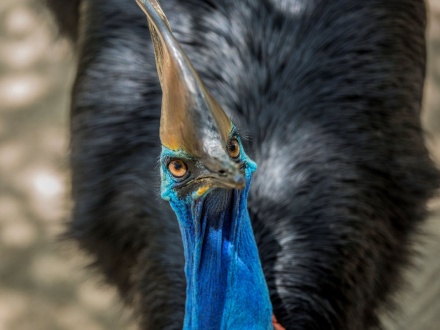
Similar to the plants in the Daintree Rainforest, this area is home to the greatest concentration of animal species that are rare, or threatened with extinction, anywhere in the world.
Estuarine Crocodile
One of the most well known animals living in the Daintree Rainforest area is the Estuarine Crocodile. This creature has been the bane of many explores and settlers in the region during the past 100 years, and it continues to be a threat to visitors to the Daintree who are unaware of the dangers associated with swimming among them.
The crocodile is from the reptile family, and has a cold-blood system which means it needs to regulate it's own body temperature closely. For this reason, it is common to see a saltwater crocodile lying still with its mouth gaping - a cooling process to maintain body temperature between 30 and 32 degrees Celsius.
A crocodile feeds upon prey with sudden fury. It will normally wait near the riverbank, very still, and pounce upon unsuspecting prey in a rapid movement. The victim is thrashed into submission, and dragged underwater where it is stashed underneath a ledge or some other obtrusion from the river. The victim is then left to soften for a few days before the crocodile returns to have a feast.
The crocodile will eat anything including smaller animals such as fish, crabs and insects. Meals also include larger animals such as turtles, birds, reptiles, dingoes, wallabies, domestic cattle, and people if you're careless.
The temperature at which a crocodile egg is kept determines the sex of the baby crocodile. If the egg is kept at 31.6 degrees Celsius it will be male. Any other temperature and the baby crocodile will be a female.
Please note that the Estuarine Crocodile became a protected species in 1970 due to overly aggressive hunting by humans. It is illegal to injure or kill a crocodile.
Cassowary
A 1993 CSIRO survey found that the number of cassowary birds in the Daintree Rainforest had fallen to an alarming amount of 54. The species that had once been strong had been reduced by unnatural threats to its habitat including collisions with vehicles, accidental trappings intended for feral pigs, and killings by dogs. As a result, the cassowary is listed as an endangered species. However, it is making a comeback. Recent estimates put the population over 500 - a significant jump in numbers since 1993.
The cassowary is vital to the wet tropics region throughout Far North Queensland because it provides a role of seed disperser for over 100 species of rainforest plants with large fruits. Without the cassowary, these plants would be concentrated around a parent plant and would not spread throughout the rainforest ecosystem.
The skin on the cassowary's head is pale blue, becoming darker further down the neck. Two swinging red wattles hang at the front of the neck with an orange patch on the back of the neck. The body is black.
The cassowary's feet have three large toes, with a spike on each foot up to 120mm long. The female cassowary is larger and more attractive than the male. Average size of the bird is 1.75 meters high.
The cassowary is flightless and is normally quite shy. However, if the bird is agitated in any way - such as being cornered in a small area, or if any animal including human approaches it's nest - it will lash out violently with its sharp claws. Serious injury can result, so avoidance of these large birds is recommended. If you see a cassowary, do not turn and run away from it. Instead, face the bird and back away slowly. Do not feed the cassowary either.
Insects
The Daintree Rainforest is home to millions of insects. To experience the feeding patterns of the insects, simply wander into a cool shady part of the forest without wearing any insect repellent.
Golden Orb Spider
Don't worry; the Golden Orb Spider is totally harmless to humans. It may look scary, but it's actually a very passive creature. The body of the spider is only 1-2 millimetres in diameter, however the legs grow to make the spider up to the size of a spread hand.
The leg joints are golden in colour. The web these spiders weave is vast in scope. They can be several metres across, and are often built at head level on hiking trails - a wonderful experience for visitors to the area!
Rufous Owl
Usually only seen at night, the Rufous Owl is more dangerous than it looks. Weighing up to 1.3 kgs, it is capable of swooping upon the nests of other birds and stealing youngsters for its nightly meal. Visitors are unlikely to see the owl during the day, so a nocturnal tour is the best option.
Musky Rat-Kangaroo
Is it a rat, or is it a kangaroo? Maybe this animal should be called a kangarat.
This small creature feeds on the leaves, insects and fallen fruits. It is most active in the early morning and late afternoon, avoiding the intense tropical heat of midday. Its sleeping bed is found among the root systems of large trees, padded with fallen leaves.
The Musky Rat-Kangaroo gets its name from the way it moves along the ground - half kangaroo jump and half rodent walk. The creature begins a hop forward by extending the forelegs, and then it brings the hind legs forward. This is an effective way of traversing the uneven ground of the rainforest.
Feral Pigs
This introduced animal is blamed for many environmental problems in the Daintree Rainforest. The large pigs thrash through the rainforest with brute strength, eating large quantities of native trees and animals. They spread the root-rot fungus with their hoofs, and contribute to the spread of exotic seeds and worms. The feral pigs are declared a pest by National Parks authorities, which estimate the population of pigs at 3 per square kilometre.
Azure Kingfisher
The Azure Kingfisher is one of eleven kingfishers in Australia, and is commonly seen in the Daintree Rainforest. Frequent contact with humans means the birds will come within 2-3 meters of visitors. It has azure blue wings, with an orange breast.
Ulysses Butterfly
The Ulysses Butterfly is an icon of Tropical Northern Australia. It has spectacular large iridescent metallic-blue wings that can be seen from a great distance.
Witchetty Grub
Not a particularly beautiful animal, the Witchetty Grub was an important source of ‘bush tucker' in years past. It lives underneath the bark of large gum trees, and resembles a thick worm. It is white in colour and is high in protein - a yummy treat for the adventurous of stomach.
Spotted Cuscus
The cuscus is very similar to a sloth - and has about the same vigour and energy too. It is a very shy nocturnal mammal that sleeps most of the day perched on a tree branch.
The body of the Spotted Cuscus is covered in tan fur, with spots of chestnut and black on the back. It has reddish-brown legs and a small round face with small eyes. The animals can be up to 80 cm long.
The unique feature that enables the Spotted Cuscus to cling upside down to tree branches is its "two-thumbed" hands. The innermost toe is opposable, creating an ideal grabbing tool.
Bandicoot
Visitors to the Daintree Rainforest often mistake the Bandicoot for a tiny kangaroo because they hop around on their hind legs. They grow to about 30 centimetres in length, with fur that ranges in colour from orange, grey, brown, or striped.
You normally only see Bandicoots at night, as they are a nocturnal creature and spend the daylight hours hiding in crevices, logs or tunnels.
Sugar Glider
The name for the Sugar Glider comes from the fact that they glide through the air and feed on sweet things like honey and sugar.
They are silvery blue grey in colour with a dark stripe on the back. Their body length is around 200mm.
Goanna
Goannas are huge lizards that can be seen high in trees, scampering along the ground, swimming over creeks, and leaping from branch to branch.
The goanna forages for food among leaves on the ground, usually eating insects, spiders, scorpions, centipedes and even small mammals.
Goannas can run quickly on their hind legs and will rear up in a two-legged posture when threatened.
White Lipped Tree Frog
The White Lipped Tree Frog is one of the largest variety of tree frog, reaching up to 14 centimetres in length. It is predominantly green in colour, with a white stripe covering its lower lip. It lives throughout the Daintree Rainforest wherever there is a water supply and plenty of shade.
The mating call is similar to a dog's bark.
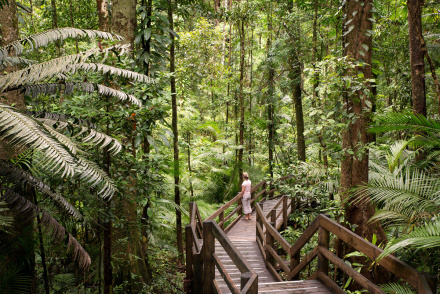
The diversity, intricacy and age of plant species in the Daintree Rainforest are greater than any other ecosystem in Australia, and many places around the world. The area is home to the greatest concentration of plant species that are rare, or threatened with extinction, anywhere in the world.
The Daintree rainforests is home to one of the highest populations of primitive flowering plants in the world. Of 19 primitive plant families on earth, 12 are found in the Daintree. A similar number of primitive families are found in all the rainforests of South America, including the Amazon Rainforest. These ancient plant families may hold secrets to a number of unanswered questions regarding the origins of the flowering plants - plants on which the human race depends for food and medicines.
Of Australia's 36 mangrove species, 28 are found in the Daintree region.
Every plant in the rainforest is placed in relation to other plants to serve a special role. Many plants cannot survive without the characteristics of another plant along side it.
It is impossible to list every plant and tree species in the Daintree Rainforest, so only a few notable plants are listed here. Needless to say, a great appreciation of the scope and variety of life in this part of the world can only be gained by visiting to the area itself.
Idiot Fruit
One of the most primitive of all the flowering plants in the Daintree Rainforest, this uniquely named plant was discovered only recently in 1970.
This plant has a quirky history relating to its discovery.
Four cattle belonging to local farmer John Nicholas from the Daintree Tea Company were unexpectedly found dead in their paddock. A veterinary officer was summoned to check the reasons for the death of the four cattle, and while he was at the property he witnessed the death of two more. Autopsies revealed the partly chewed remains of large seeds in the cattle's stomachs. After scientific examination, it was found that that the seeds produced a poison similar to strychnine, and they were responsible for the death of the cattle. These seeds were from the Idiot Fruit.
Blue Quandongs
This is a giant of the rainforest. The Blue Quandon is an integral part of the rainforest canopy layer, hiding the sun from plants below it. It has a blue fruit about 3cm in diameter.
Burrawang Palm
A member of the Cycad family, this palm produces highly toxic seeds.
Wild Ginger
Members of the ginger family often contain poison, so an intricate knowledge of the types of ginger plants is required before attempting to eat any. This ginger grows up to six metres high, and is occasionally used to supplement drinking water for hikers who are thirsty. By chopping the ginger near the ground, water will drain out of the stem.
Wait-a-while vine
Watch out for these vines when hiking through the rainforest. The thin strands of vine are covered with small spikes that grab clothing, rip at skin, and generally tear up anything that comes within reach of them. The vines hang from large trees to the rainforest floor and can be gathered in thick clumps in places.
Stinging Tree
This is a tree to be avoided at all costs. Any cost.
It has large leaves that look harmless, but they are covered with thousands of microscopic pricks that embed themselves into skin if touched. And these little blighters itch like crazy. So just remember not to touch them because you'll go through a lot of pain and trouble!
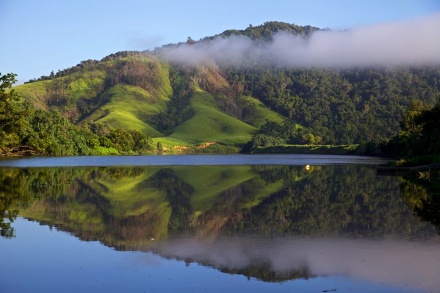
Daintree Village was originally a settlement created in the 1870's by timber-cutters and is now an unspoilt oasis in the midst of some of the loveliest and most varied scenery in the far north of Queensland. Today low-impact tourism and sustainable cattle- and tropical fruit-farming in the beautiful valleys beyond the Village form the lifeblood of this laid-back little township with all it's charm of yesteryear.
Daintree Village was the base for timber-cutters who came to log the red cedar which once flourished in the area. Today the timber industry is long-gone but there is an interesting timber gallery, featuring beautiful work by a local craftsman.
The Village hosts a number of restaurants, artists' studios, locally-created souvenirs and picnic areas complete with free electric barbeque and picnic table. There are guided walks, river cruises and an exciting 8wd Argo tour.
Crocodile express
The mighty Daintree River flows past the Village and is home to many estuarine crocodiles which are frequently spotted from the safety of one of a number of wildlife-watching cruise-boats which leave from the Village jetty. Birds and butterflies abound - the Daintree Village region is a world-renowned birdwatcher's paradise and there are several specialist guides.
Accommodation choices in the Village and it's surrounding valleys range from a famous spa resort, traditional B&Bs, retreats, farm-stays to budget cabins.
Beyond the Village are scenic drives which take the visitor along winding valley trails which follow the courses of the upper reaches of the Daintree and into the valleys of Stewart Creek, Douglas Creek and Upper Daintree through a delightful mix of rolling green cattle country and areas of lush tropical rainforest.
The cattle are tropical breeds now bred for their beef whereas in earlier days there was a thriving dairy industry. The butter factory in Daintree finally closed down in 1962 when it was no longer profitable to produce butter there. Descendants of the original settlers still live here, some operating thriving beef-cattle properties.
Daintree Valley
The Daintree River was only discovered by Europeans in 1873 when Scottish geologist and explorer George Elphinstone Dalrymple named the river and the first settlement, Daintree Village, after Queensland's Agent-General in London, Richard Daintree. Before the road to Mossman was completed in 1933 Daintree Village was an inland port with the only access being by river.
The Village gave it's name to the famous World Heritage-listed Daintree National Park which stretches in sections between Mossman Gorge in the south to the Bloomfield River in the north.
So, if you are seeking a quiet, relaxing base from which to explore all that the tropical north has to offer, the Daintree Village region has everything you could wish for.
By Daphne Titus-Rees
www.daintreevalleyhaven.com.au
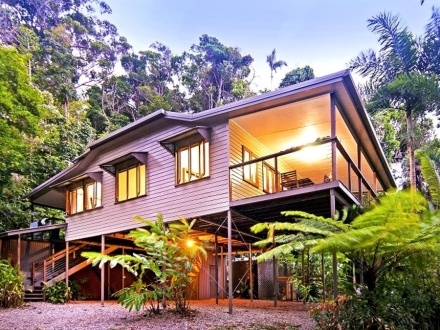
The Daintree rainforest and surroundings areas cannot possibly be explored in just one day. Fortunately, a variety of Daintree accommodation options are available to make your stay a truly magical experience. The Daintree area has accommodation to suit each visitor's tastes and budget.
Accommodation ranges from luxury four star resorts, to boutique cabins, luxurious rainforest retreats, self contained holiday houses, backpackers and camping grounds all featured in unique settings.